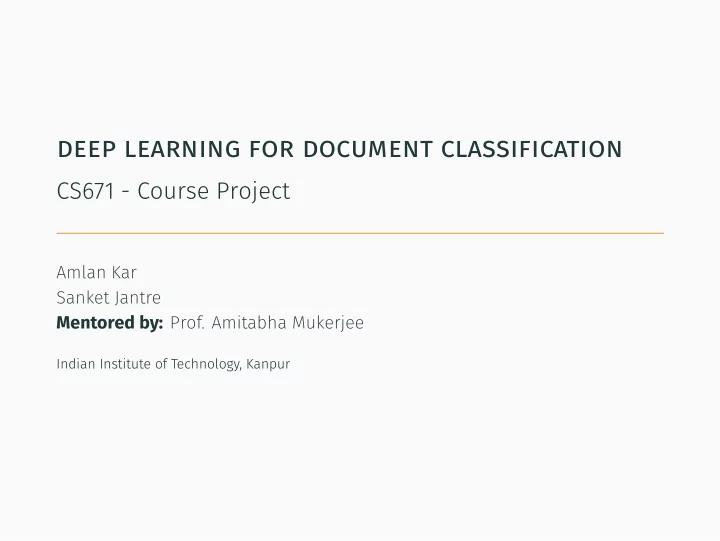

CS671 - Course Project Amlan Kar Sanket Jantre Indian Institute of Technology, Kanpur deep learning for document classification Mentored by: Prof. Amitabha Mukerjee
vectors for efficient semantic representation for application in Document and Sentence Classification tasks. ∙ Results in (Y.Kim, EMNLP 2014)[1] show promise and scope. 1 Motivation ∙ Creation and usage of new task-specific Sentence and Word level
∙ Breaking State of the Art barriers in computer vision (Krizhevsky et al., 2012) and speech recognition (Graves et al., 2013), ∙ Recent advances in standard NLP tasks have all come through the application of Deep Learning in tandem with Statistical Methods in ensemble learners. 2 Why Deep Learning ?
∙ Possibility of parse-tree like feature graphs (by looking at the firing neurons) that show induced non-linear composition used for classification in NLP tasks. 3 Why Convolutional Neural Networks ? Figure: Image from (Kalchbrenner et al., 2014) [2]
We plan to model our sentence or document as a 2D matrix using word2vec embeddings[3] of words for sentences and Skip-Thought embeddings[4] of sentences for documents. 4 Approach Figure: Image from (Y.Kim, 2014) [1]
input. during training. generate much better semantic embeddings[1]. It also seems natural, as we humans seem to apply domain specific knowledge to a general model while solving a specific problem. Why not have domain specific fine-tuned vectors? 5 Approach Static Channel: The case where we treat the word vectors as static Non-Static Channel: The case where we fine-tune the word vectors Rationale: The Non-Static channel method has been shown to
6 Approach Figure: Image from (Y.Kim, 2014) [1]
7 Approach - Sentence
8 Approach - Document
9 ConvNet Structure Figure: Multi-channel ConvNet[1]
Our ConvNet structure is slight variant of the one proposed by Collobert et al. (2011)[5] and similar to the one used by Kim. (2014)[1]. ∙ We propose to employ wide-convolution instead of simple convolution that was used by Y.Kim. ∙ We will do a k-max-over-time pooling instead of normal max-over time pooling and concatenate to get the FC-1 layer input. 10 ConvNet Structure
∙ Datasets collected for various core NLP tasks. ∙ ConvNet code almost complete. ∙ Implementation Details ∙ Code has been written in Python using the Theano deep learning library and the Keras library. ∙ Mini-batch SGD is used for backpropagation. ∙ We will use both a ReLU and a tanh non linearity and compare. ∙ Dropout is being used in the Fully connected layer to prevent co-adaptation of features. ∙ Word vectors are obtained from Google’s trained model on the Google News dataset. ∙ Skip-thought vectors are obtained from the RNN encoder-decoder model released by Ryan Kiros. 11 Work Done
∙ We intend to try and fine-tune phrase vectors if this work gets done in time. For this, we intend to use Collobert’s Senna software for phrase chunking before vector production by composition on word-vectors as suggested by Mikolov et al.[3]. ∙ Train word2vec on a Hindi corpus before employing this method on the Hindi Movie Review sentiment classification task. ∙ We also wish to try out this method on Multi-class document classification which is a field that has not been touched significantly by the deep learning revolution yet. 12 Future Work
13 Done!
Yoon Kim. Convolutional neural networks for sentence classification. EMNLP 2014 , 2014. Nal Kalchbrenner, Edward Grefenstette, and Phil Blunsom. A convolutional neural network for modelling sentences. arXiv preprint arXiv:1404.2188 , 2014. Tomas Mikolov, Ilya Sutskever, Kai Chen, Greg S Corrado, and Jeff Dean. Distributed representations of words and phrases and their compositionality. In Advances in neural information processing systems , pages 3111–3119, 2013. 14 References I
Ryan Kiros, Yukun Zhu, Ruslan Salakhutdinov, Richard S Zemel, Antonio Torralba, Raquel Urtasun, and Sanja Fidler. Skip-thought vectors. arXiv preprint arXiv:1506.06726 , 2015. Ronan Collobert, Jason Weston, Léon Bottou, Michael Karlen, Koray Kavukcuoglu, and Pavel P. Kuksa. Natural language processing (almost) from scratch. CoRR , abs/1103.0398, 2011. 15 References II
Recommend
More recommend